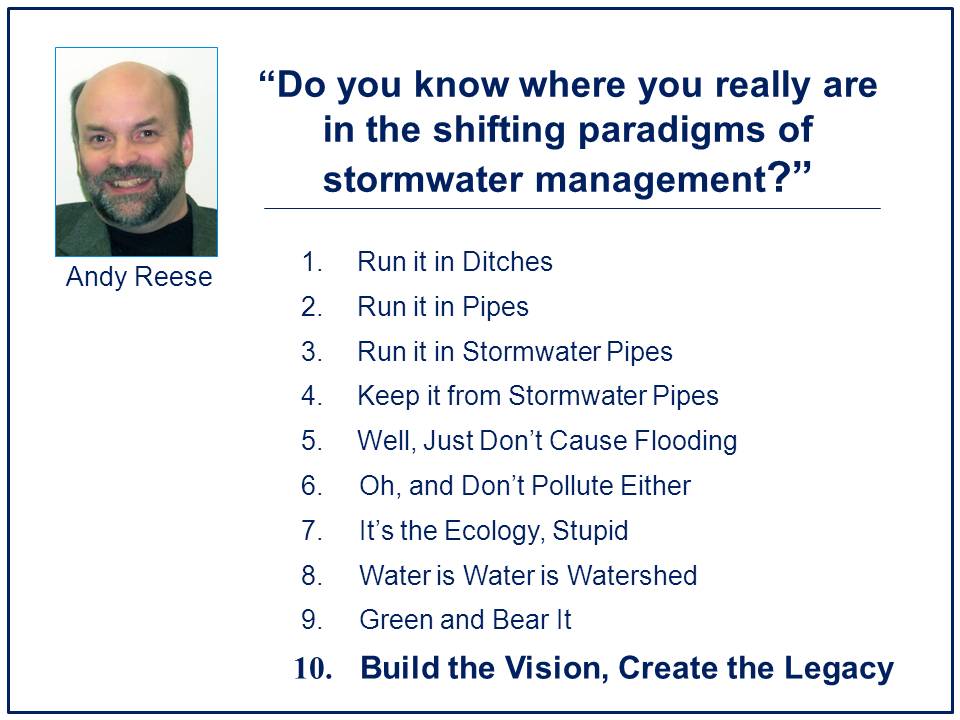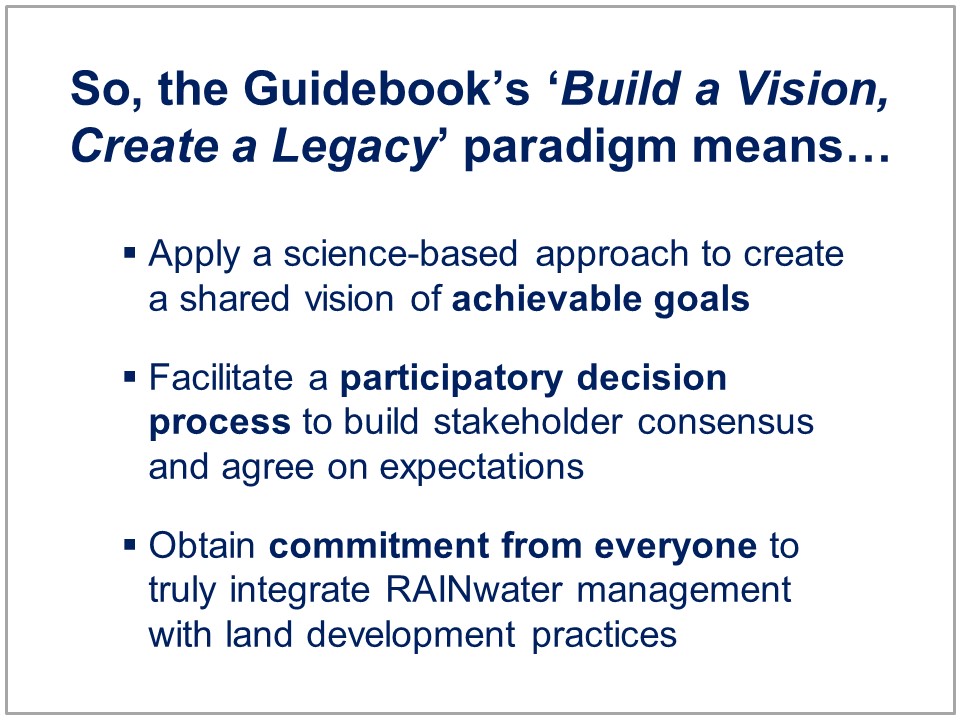Mantra for Sustainable Rainwater Management in British Columbia: "Build a Vision, Create a Legacy"

Nine Paradigms Explained: In 2001, Andy Reese examined how our ideas about “stormwater” have changed over time
Andy Reese is a leading American water resources engineer and popular writer, speaker, and co-author of the best-selling textbook Municipal Stormwater Management. He is known for his mantra: Stormwater – Back to the Future.
Paradigms Comprise a Continuum
In the July/August 2001 issue of Stormwater Magazine, Andy Reese took an irreverent look at how our ideas about stormwater have changed since the 1800s. In his article titled “Stormwater Paradigms”, Andy Reese insightfully looks back at why we pursued stormwater management in ways which unknowingly – at the time – foreclosed opportunities for more sustainable, livable communities. Reese describes a paradigm shift as follows:
 “It’s what we think is true and right about a certain subject. It’s the grid through which we put all information and input about a subject. In fact, it’s everything we think is true about something …..Whether our paradigm is, in fact, true and effective is not the point. We believe it is. And we only reluctantly change our ways and agree with someone else’s paradigm. Stormwater management is full of cantankerous people with strongly-held opinions.”
“It’s what we think is true and right about a certain subject. It’s the grid through which we put all information and input about a subject. In fact, it’s everything we think is true about something …..Whether our paradigm is, in fact, true and effective is not the point. We believe it is. And we only reluctantly change our ways and agree with someone else’s paradigm. Stormwater management is full of cantankerous people with strongly-held opinions.”
These paradigms comprise a continuum. People and communities progress at different rates along the continuum – nearby communities in the same region may even be guided by different paradigms. It is much easier to know what the next paradigm is than to move into the next paradigm. The nine paradigms as defined by Reese are listed above.
To Learn More:
To read the complete Andy Reese article, click on this link to download a copy of Stormwater Paradigms
What is the Tenth Paradigm?
“After his article was published, I said to Andy, an obvious question is …so, what is the tenth paradigm? …. because people are used to lists of ten. You have only nine,” recalls Kim Stephens, Executive Director with the Partnership for Water Sustainability in British Columbia.
 “From a British Columbia perspective, it actually was fortuitous that Andy limited himself to nine paradigms. At the time, we were in the final stages of writing Stormwater Planning: A Guidebook for British Columbia. Long story short, Andy provided us with timely inspiration to brand the Guidebook approach as representing the Tenth Paradigm. In retrospect, it was serendipity the way things came together, in particular because we were breaking new ground with the water balance methodology and all that it entailed.”
“From a British Columbia perspective, it actually was fortuitous that Andy limited himself to nine paradigms. At the time, we were in the final stages of writing Stormwater Planning: A Guidebook for British Columbia. Long story short, Andy provided us with timely inspiration to brand the Guidebook approach as representing the Tenth Paradigm. In retrospect, it was serendipity the way things came together, in particular because we were breaking new ground with the water balance methodology and all that it entailed.”
Build a Vision, Create a Legacy
“In 2002, three of us collaborated with Andy Reese to co-author an article that was published in FreshOutook Magazine. This article introduced the Tenth Paradigm: Build a Vision, Create a Legacy,” continues Kim Stephens.
“In the article, we stated that the ‘Tenth Paradigm’ reaches beyond rainwater/stormwater and associated professionals to engage broader society. We explain that it involves a wholesale transformation of society’s relationships with water (like anti-smoking or anti- litter), so that the very fabric of society changes over a generation to appreciate and learn to live with urban nature in all its dimensions,” states Erik Karlsen, co-author.
litter), so that the very fabric of society changes over a generation to appreciate and learn to live with urban nature in all its dimensions,” states Erik Karlsen, co-author.
A former Director of Regional Growth Strategies in the BC Ministry of Municipal Affairs, Erik Karlsen later served five years (2005 through 2010) as Chair of the Agricultural Land Commission.
“We can begin to think about the Tenth Paradigm as one involving making decisions aimed at achieving healthier urban watersheds over time. We emphasized that a shared long-term vision is needed to focus the effort that will create a legacy,” continues Robert  Hicks, a Senior Engineer with the Metro Vancouver regional government.
Hicks, a Senior Engineer with the Metro Vancouver regional government.
“The shared vision provides a context for all planning, data collection, sensitivity analyses, capital expenditures, and regulatory changes. We explained that prioritizing goals and actions (ideally through consensus) provides a road map for moving towards a target condition.”
To Learn More:
To read the FreshOutlook article in its entirety, click on Stormwater Management: Build a Vision, Create a Legacy. The article provides a philosophical backdrop for Stormwater Planning: A Guidebook for British Columbia, published in 2002.




